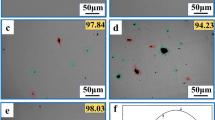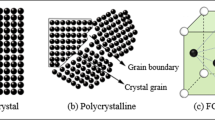Abstract
Ni-based GH625 superalloy has been widely employed in the aerospace industry due to its high strength, outstanding corrosion resistance, and high-temperature resistance. A novel hybrid processing method of ultrasonic-assisted electrochemical grinding (UAECG) can achieve a high effective removal rate for difficult-to-process materials and thereby avoid stray corrosion during the process. This study systematically investigated the electrochemical dissolution behaviors of GH625 alloy at low current density and the effects of processing parameters on its surface roughness. A qualitative model was proposed to further reveal its removal mechanism for GH625 alloy during the UAECG process. Polarization curves depicted that an efficient and stable electrochemical dissolution was achieved at an appropriate temperature (20 °C) and concentration (10 wt.%) of NaNO3 electrolyte. The findings also revealed that selective corrosion preferentially occurred on the grain boundary or near the NbC carbides under different current density corrosion circumstances. Compared with the ECG process, the excellent surface quality (Ra = 0.37 μm) and taper of the small holes (taper = 0.04 ± 0.005°) are obtained at the optimized condition of a pulse voltage of 5.8 V, feed rate of 0.6 mm/min, cathode speed of 12 kr/min and drive amplitude of 60% by UAECG technology.



















Similar content being viewed by others
References
Lee J, Terne M, Jun S, Hong HU, Copin E, Lours P (2020) Heat treatments design for superior high-temperature tensile properties of Alloy 625 produced by selective laser melting. Mater Sci Eng A-Struct Mater Prop Microstruct Process 790: 139720
Saoubi RM, Axinte D, Soo LS (2015) High performance cut-ting of advanced aerospace alloys and composite materials. CIRP Ann-Manuf Technol 64(2):557–580
Singh H, Jain PK (2018) Study on ultrasonic-assisted electrochemical honing of bevel gears. Proc Inst Mech Eng Part B-J Eng Manuf 232 (4): 705 -712
Li SS, Wu YB, Nomura N (2016) Fundamental Investigation of Ultrasonic Assisted Pulsed Electrochemical Grinding of Ti-6Al-4V. Mater Sci Forum 874:279–284
Prasanth NA, Yuan LJ, Yeo HS (2020) Multi-jet hydrodynamic surface finishing and X-ray computed tomography (X-CT) inspection of laser powder bed fused Inconel 625 fuel injection/spray nozzles. J Mater Process Technol 291:117018
Lauwers B, Klocke F, Klink A (2014) Hybrid processes in manufacturing. CIRP Ann-Manuf Technol 63 (2): 561–583
Dhokia ZZGV, Nasseh A (2013) A review of hybrid manufacturing processes –state of the art and future perspectives. Int J Comput Integr Manuf 26 (7): 596–615
Zhan D, Han L, Zhang J, He Q, Tian ZW, Tian ZQ (2017) Electrochemical micro/nanomachining: Principles and practices. Chem Soc Rev 46(5):1526–1544
Meng L, Zeng Y, Zhu D (2017) Investigation on wire electrochemical micro machining of Ni-based metallic glass. Electrochim Acta 233:274–283
Datta M (1998) Microfabrication by electrochemical metal removal. Res Dev 42(5):655–669
Silva AD, McGeough JA (1998) Process monitoring of electrochemical machining. Mater Process Technol 76:165–169
Zhan D, Han L, Zhang J, Shi K, Zhou JZ, Tian ZW, Tian ZQ (2016) Confined chemical etching for electrochemical machining with nanoscale accuracy. Accounts Chem Res 49(11):2596–2604
Mount AR, Howarth PS, Clifton D (2001) The use of a segmented tool for the analysis of electrochemical machining. J App Electrochem 31(11):1213–1220
Zhu Z, Wang D, Bao J, Wang N, Zhu D (2015) Cathode design and experimental study on the rotate-print electrochemical machining of revolving parts. Int J Adv Manuf Technol 80:1957–1963
Schuster R, Kirchner V, Allongue P (2000) Electrochemical micromachining. Science 289(5476):98–101
Ahn HS, Ryu HS, Choi KD (2004) Electro-chemical micro drilling using ultra short pulses. Pre Eng 28(2):129–134
Bilgi DS, Kumar R, Jain VK (2008) Predicting radial overcut in deep holes drilled by shaped tube electrochemical machining. Int J Adv Manuf Technol 39(1–2):47–54
Lupak M, Zaborski S (2009) Simulation of energy consumption in electrochemical grinding of hard-to-machine materials. J Appl Electrochem 30(1):101–106
Sagarwal S (2015) On the mechanism and mechanics of material removal in ultrasonics machining. Int J Mach Tool Mnuf 96:1–14
Li S, Wu Y, Nomura M (2018) Fundamental Machining Characteristics of Ultrasonic-Assisted Electrochemical Grinding of Ti6Al4V. J Manuf Sci Eng-Trans ASME 140(7) : 071009
Li S, Wu Y, Nomura M (2016) Fundamental investigation of ultrasonic assisted pulsed electrochemical grinding of Ti6Al4V. Mater Sci Forum 4389:279–284
Wu Y, Li S, Nomura M (2017) Ultrasonic assisted electrolytic grinding of titanium alloy Ti6Al4V. Int J Nano manuf 13(2):152–160
Yin Y, Zhang J, Ma Y, Huo J, Zhao K, Meng X, Han Q, Yin J (2020) Electrochemical Dissolution Behavior of Nickel-Based Hastelloy X Superalloy at Low Current Densities. IEEE Access 8:62714–62724
Yin Y, Zhang J, Yang S, Liu T, Han Q, Zhang Z, Yang H (2021) Effect of microstructure on the electrochemical dissolution behaviour of Hastelloy X superalloy processed by selective laser melting and heat treatments. Mater Des 206:109828
Yin Y, Zhang J, Huo J, Zhao K, Zhu X, Han Q, Ma Y, Fu Z, Yin J (2020) Effect of microstructure on the passive behavior of selective laser melting-fabricated Hastelloy X in NaNO 3 solution. Mater Charact 165:110375
Guo P, Lin X, Xu J, Li J, Liu J, Huang W (2017) Electrochemical removal of different phases from laser solid formed inconel 718. J Electrochem Soc 164(7):151–157
Guo P, Lin X (2017) Huang W (2017) Columnar structure and electrochemical anisotropy of a nickel-based superalloy fabricated via laser solid forming. J Appl Electrochem 47:1083
Kozak J, Oczoś KE (2001) Selected problems of abrasive ECDG process. J Mater Process Tech 109:360–6
Haisch T, Mittemeijer E, Schultze JW (2001) Electrochemical machining of the steel 100Cr6 in aqueous NaCl and NaNO3solutions: Microstructure of surface films formed by carbides. Electrochim Acta 47(9):1083–1090
Wang D, Zhu Z, He B, Ge Y, Zhu D (2017) Effect of the breakdown time of a passive film on the electrochemical machining of rotating cylindrical electrode in NaNO3 solution. J Mater Process Technol 239:251–257
Weber O, Weinmann M, Natter H, Bähre D (2015) Electrochemical dissolution of cast iron in NaNO3 electrolyte. J Appl Electrochem 4(6):591–609
Rosenkranz C, Lohrengel MM, Schultze JW (2005) Microscopic investigations of electrochemical machining of Fe in NaNO3. Electrochim Acta 48(20–22):3203–3211
Funding
This work was supported by the [National Key R&D Program] ([No. 2018YFB1105900]).
Author information
Authors and Affiliations
Contributions
All authors have contributed to the research conception and design. Material preparation, data collection and analysis were carried out by YY, JZ, JH, and YM. The first draft was written by YM. All authors commented on previous versions of the manuscript. The final draft read and approved by all authors.
Corresponding author
Ethics declarations
Competing interests
The authors declare that they have no competing interests.
Additional information
Publisher's note
Springer Nature remains neutral with regard to jurisdictional claims in published maps and institutional affiliations.
Rights and permissions
About this article
Cite this article
Ma, Y., Yin, Y., Zhang, J. et al. Effects of processing parameters on the surface quality of wrought Ni-based superalloy by ultrasonic-assisted electrochemical grinding. Int J Adv Manuf Technol 121, 7851–7865 (2022). https://doi.org/10.1007/s00170-022-09562-w
Received:
Accepted:
Published:
Issue Date:
DOI: https://doi.org/10.1007/s00170-022-09562-w




